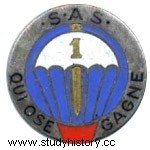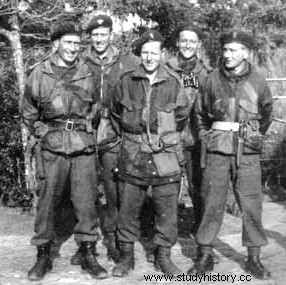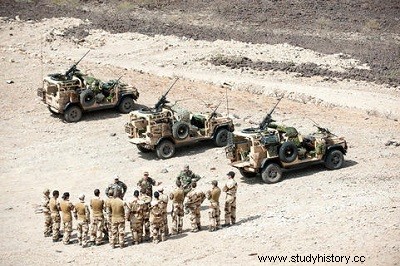1st Marine Infantry Parachute Regiment

The 1st Marine Infantry Parachute Regiment, regiment of the French army, is classified as a special forces regiment. It is integrated into the Land Special Forces Brigade (BFST), itself under the command of the Special Operations Command (COS) and the Army General Staff (EMAT).
Maintaining the tradition of SAS (Special Air Service) parachute units (Free France and Indochina), this regiment is the only French-speaking unit to be able to claim the motto:"Qui Ose Gagne" which is that of the British SAS "Who Dares Wins ". The French SAS flag was the most decorated Allied emblem during World War II.
Basic training is RAPAS training (airborne search and specialized action). Then come the specialties:COUNTER TERRORISM (CT), TE/TELD (snipers), GDC (bodyguards), PAT SAS (specialized SAS patrols in the desert), droppers OPS and SOTGH (Operational jump at very high height ), RPO (Rapas diver offensive), jungle, mountain etc.
The General Bergé citadel in Bayonne - named after the officer who created the paratroopers of Free France and the French SAS - also regularly welcomes foreign special forces units as part of skills exchanges.
History of garrisons, campaigns and battles

Heir to the 1st Colonial Parachute Commando Demi-Brigade whose origins date back to the Second World War.
Under the leadership of Captain Georges Bergé, the 1st Air Company was created in England September 15, 1940, with the parachute units of the Special Air Service (SAS) (1 CCP/SAS created in 1941 in Scotland). This company was engaged from 1942 to 1944 in Crete, Libya, Tunisia, Brittany, Belgium, Holland, during the Battle of the Ardennes then in Germany.
The company was then dissolved and named demi-brigade SAS paratroopers from 1946 to 1949, then 1st colonial paratrooper commando demi-brigade from 1949 to 1955 in Indochina, Hanoi, Nam Dinh, Plaine des Joncs, Dong Khê, Hoa-Binh, Cao-Bang, Tu-Le, Nasam, Lang-Son, Diên Biên Phù, then BPC in Algeria from 1955 to 1958 Suez, Bizerte, the BCCP dissolved and renamed from 1959 to 1960 GIBPOM then in 1960 BPCMa and renamed in 1962 1st RPIMa which has custody of the SAS emblem .
Successive garrisons
September 1940:Ringway (England)
1941:Garrison in Beirut, then in Damascus.
1942:Garrison in Kabrit on the Suez Canal.
1943:Garrison in Camberley, United Kingdom
After the war return of the garrison to France
1960:Creation of the 1st RPIMA and garrison in Bayonne
World War II
September 1940:creation and training at Ringway (England).
March 15, 1941:Operation Savanna, the first FFL operation in France (ambush in Brittany).
May 1941:Operation Joséphine B (destruction of six transformers at the Pessac power plant).
Division into a section assigned to the BCRA, and two sections sent to the Middle East.
July 21, 1941:embarkation for the Middle East, then garrison in Beirut, then Damascus.
January 2, 1942:the section is attached to the special forces of the SAS of David Stirling and takes its garrison in Kabrit on the Suez Canal.
June 1942:the French SAS destroy 20 German planes in Crete, then attack the airfields of Matouba-Derna, Benina, Barce and Benghazi on the Libyan front.
July 1942:operations in Cyrenaica.
January 1943:harassment of the German rear in Tunisia.
Spring 1943:rest and training at Camberley (England).
Early 1944:French SAS training in Scotland.
Night of June 5 to 6, 1944:parachute drop in Brittany, 36 FFL paratroopers in 4 groups (2 on Plumelec, 2 on Duault). One killed in combat at Plumelec on June 6 at 00:40 a.m., Corporal Emile Bouétard, probable 1st death of the Landings. Duault, Côtes-d'Armor; the battalion (450 parachuted men), with the FFI (3000 men in total), retains 85,000 Germans in Brittany (who cannot reach Normandy), and operates its junction with 2 divisions of George Patton's army on August 6 .
August 1944:raids as far as Bordeaux, Périgueux (equipped with jeeps with Vickers machine guns mounted on mountings), on the right bank of the Loire. SAS also took part in the liberation of Paris.
September 11, 1944:a company took 3,000 German prisoners.
Autumn:rest in Champagne.
November 11, 1944:the 2 French SAS regiments parade on the Champs-Elysées in Paris in front of General de Gaulle and English Prime Minister Winston Churchill.
December 30, 1944:reinforcement during the Battle of the Ardennes.
February 1945:regrouping in England.
Night of April 7 to 8, 1945:Operation Amherst, parachuting in the Netherlands. Fights until the 18th.
Indochina War
After an initial stay of 2 years, the battalion left Indochina on January 19, 1951.
He returned to Indochina in August 1953. In November 1953, he took part in Operation Castor (Occupation of Dien Bien Phu). In December 1953, he was sent to Seno in Middle Laos to counter the Viet Minh offensive in the region. At the beginning of May 1954, the situation in Diên Biên Phù seemed hopeless. The battalion was dropped on the entrenched camp in small company-sized detachments:one company on the night of May 1-2, 94 men on the night of May 5-6. These will be the last reinforcements sent to Diên Biên Phù before the end of the camp's resistance on May 7, 1954.
Since 1962
On November 1, 1960, the 1st Marine Infantry Parachute Regiment was created in Bayonne. It is the training unit for paratroopers.
With the professionalization of the parachute regiments, they took charge of the training of their personnel. The 1st RPIMa mutates by moving towards intelligence and action. In 1974, the Operational Group (GO) was created, which is employed by the Action department of the External Documentation and Counterintelligence Service (SDECE, French special services). He participated in particular in Operation Caban (overthrow of Bokassa in the Central African Republic in 1979) but he was criticized by the SDECE for having operated too visibly, in uniform. The GO was dissolved in 1981.
The 1st RPIMa is refocusing on less secret missions, by bringing together the operational assistance detachments (DAO) which assist the allied forces, particularly in Africa. It also specializes as a human search unit (reconnaissance) by providing corps search units (URCA) to the army corps (the 13th RDP having the same role at the level of the 1st Army).
During the Gulf War (1991), the 1st RPIMa supervised a group of deep action commandos (CRAP) provided by the regiments of the 11th parachute division which was assigned to the Daguet division. Two paratroopers of the 1st RPIMa were killed by the explosion of undetonated submunitions in the fort of As Salman on February 26, 1991.
In 1992, the 1st RPIMa was assigned for employment to the newly created Special Operations Command (COS). In 1997, he left the 11th Parachute Division to join the Groupement Spécial Autonome which became the Special Forces Land Brigade (BFST).
Since that date, the regiment will participate in the various operations carried out by the COS and the French army. Among them, we can mention the interventions in the Balkans (in 1995 and 1999 to capture war criminals), Afghanistan (Operation Ares) or the Sahel, culminating in Operation Serval in Mali. During these actions, the 1st RPIMa will implement many of its skills:release of hostages, evacuation of nationals, long-distance patrol....
Traditions
Party of the Marines
It is celebrated on the occasion of the anniversary of the fighting in Bazeilles, this village which was recaptured four times and abandoned on orders, on August 31 and September 1, 1870.
And in the Name of God, long live the colonial!
The Porpoises and the Bigors have God himself as their patron saint. This battle cry ends the intimate ceremonies that are part of regimental life. Its origin is a thanksgiving of the Reverend Father Charles de Foucauld, missionary, seeing the colonial units come to his aid one day when he was in difficulty with a local tribe.
Organization
In 2005, we know that the 1st marine infantry parachute regiment was organized around the following units:a command and logistics company (CCL), a transmission-rapas company, three RAPAS combat companies and an operational preparation company and instruction. Each company has its specialty. Thus the 1st company specialized in combat in urban and aquatic environments and it includes within it teams of operational droppers. As for the 2nd company, its center of excellence is in combat in extreme environments such as the equatorial forest or areas in high mountains. Finally, the 3rd combat company specialized in SAS patrols on light armed vehicles (tradition of SAS armed jeeps 1942-1945) and support.

By its volume and by the RAPAS domain, the 1st RPIMa is a Special Forces regiment without equivalent within the Army and the Special Operations Command, the RAPAS domain allowing each element of the RAPAS companies to accumulate a large number of very useful qualifications over the years. It is also an extremely versatile regiment and can intervene in any type of environment. Very projectable, very professional and very effective, the 1st RPIMa is part of all the detachments and external operations of the French army, but always engaged very discreetly.
